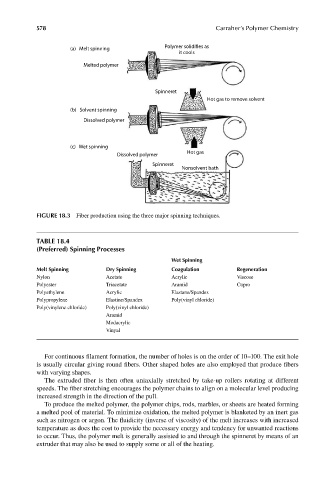Page 615 - Carrahers_Polymer_Chemistry,_Eighth_Edition
P. 615
578 Carraher’s Polymer Chemistry
Polymer solidifies as
(a) Melt spinning
it cools
Melted polymer
Spinneret
Hot gas to remove solvent
(b) Solvent spinning
Dissolved polymer
(c) Wet spinning
Hot gas
Dissolved polymer
Spinneret
Nonsolvent bath
FIGURE 18.3 Fiber production using the three major spinning techniques.
TABLE 18.4
(Preferred) Spinning Processes
Wet Spinning
Melt Spinning Dry Spinning Coagulation Regeneration
Nylon Acetate Acrylic Viscose
Polyester Triacetate Aramid Cupro
Polyethylene Acrylic Elastane/Spandex
Polypropylene Elastine/Spandex Poly(vinyl chloride)
Poly(vinylene chloride) Poly(vinyl chloride)
Aramid
Modacrylic
Vinyal
For continuous filament formation, the number of holes is on the order of 10–100. The exit hole
is usually circular giving round fibers. Other shaped holes are also employed that produce fi bers
with varying shapes.
The extruded fiber is then often uniaxially stretched by take-up rollers rotating at different
speeds. The fiber stretching encourages the polymer chains to align on a molecular level producing
increased strength in the direction of the pull.
To produce the melted polymer, the polymer chips, rods, marbles, or sheets are heated forming
a melted pool of material. To minimize oxidation, the melted polymer is blanketed by an inert gas
such as nitrogen or argon. The fl uidicity (inverse of viscosity) of the melt increases with increased
temperature as does the cost to provide the necessary energy and tendency for unwanted reactions
to occur. Thus, the polymer melt is generally assisted to and through the spinneret by means of an
extruder that may also be used to supply some or all of the heating.
9/14/2010 3:43:36 PM
K10478.indb 578 9/14/2010 3:43:36 PM
K10478.indb 578

